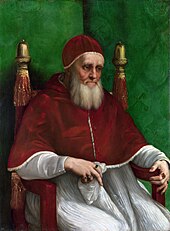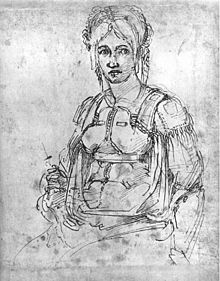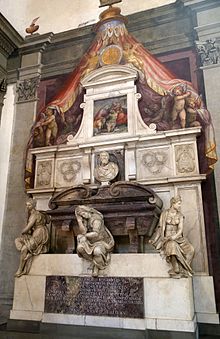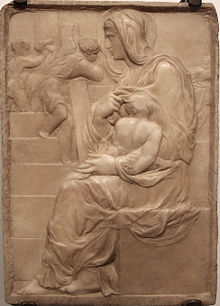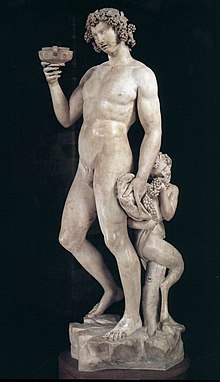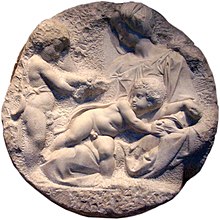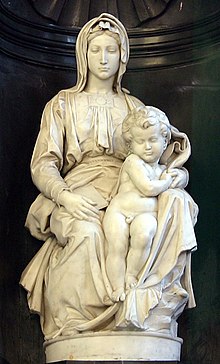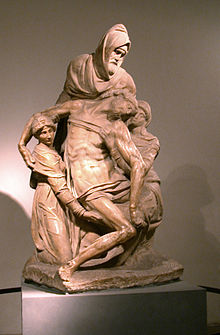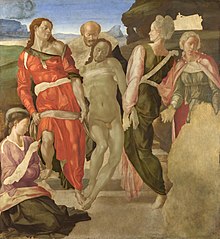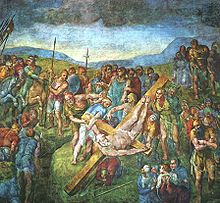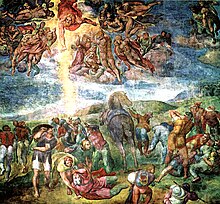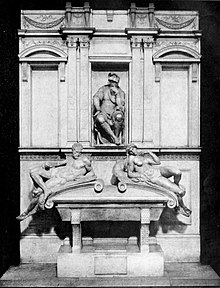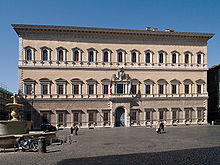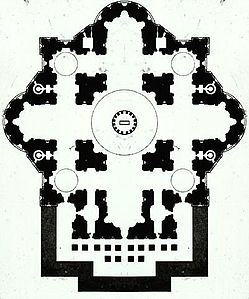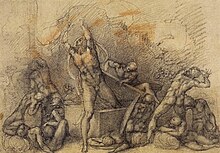Miguel Angel
Michelangelo Buonarroti (Caprese, March 6, 1475-Rome, February 18, 1564), known in Spanish as Michelangelo, was an architect, sculptor, Renaissance Italian painter and poet, considered one of the greatest artists in history both for his sculptures and for his paintings and architectural work. He developed his artistic work over more than seventy years between Florence and Rome, which was where they lived his great patrons, the Medici family of Florence and the different Roman popes.
He was the first Western artist to have two life biographies published: Le vite de' più eccellenti pittori, scultori e architettori, by Giorgio Vasari, published in 1550 in its first edition, in which he was the only living artist included, and Vita de Michelangelo Buonarroti, written in 1553 by Ascanio Condivi, painter and disciple of Michelangelo, who collects the data provided by Buonarroti himself. He was greatly admired by his contemporaries, who called him the Divine. Benedetto Varchi, on 12 February 1560, he sent him a letter on behalf of all Florentines telling him:
... this whole city wants to be able to see and honor you both closely and far... Your Excellency would do us a great favour if you would like to honour your homeland with your presence.Tolnay (1978, p. 14)
He triumphed in all the arts in which he worked, characterized by his perfectionism. Sculpture, as he had declared, was his favorite and the first to which he dedicated himself; next, painting, almost like an imposition by Pope Julius II, and which materialized in an exceptional work, the vault of the Sistine Chapel; and already in his later years, he carried out architectural projects. He was the author of numerous works, of which today between 40 and 50 sculptures, 4 paintings, several dozen drawings and the frescoes in the Sistine Chapel and the Pauline Chapel are preserved.
Biography
Family
He was born on March 6, 1475, in Caprese, a Tuscan village near Arezzo. He was the second of five sons born to Ludovico di Leonardo Buonarroti di Simoni and Francesca di Neri of the Miniato di Siena. Mother died in 1481, when Michelangelo was six years old. The Buonarroti Simoni family had lived in Florence for more than three hundred years and had belonged to the Guelph party; many of them had held public office. The economic decline began with the artist's grandfather, and his father, who had failed to maintain the family's social position, lived on occasional government jobs, such as mayor of Caprese around the time Miguel was born. Angel. They returned to Florence, where they lived on a small income from a marble quarry and a small farm they had in Settignano, the town where Michelangelo had lived during the long illness and death of his mother; there he was left in the care of a stonecutter's family.
His father made him study grammar in Florence with the teacher Francesco da Urbino. Miguel Ángel wanted to be an artist, and when he told his father that he wanted to follow the path of art, they had many discussions, since at that time it was a little recognized profession. Ludovico di Leonardo considered that this work was not worthy of the prestige of his lineage. Thanks to his firm decision, and despite his youth, he managed to convince him to let him follow his great artistic inclination, which, according to Michelangelo, already came from the nurse he had had, the wife of a stonecutter He commented about her: "Together with my nurse's milk I also suckled the scarps and hammers with which I have later sculpted my figures."
He maintained good family relationships throughout his life. When his older brother, Leonardo, became a Dominican monk in Pisa, he assumed responsibility for running the family. He was in charge of taking care of the Buonarroti heritage and expanded it with the purchase of houses and land, as well as arranged the marriage of his nephews Francesca and Leonardo with good families from Florence.
Learning
From a very young age, he manifested his artistic talents for sculpture, a discipline in which he began to excel. In April 1488, at the age of twelve and thanks to the advice of Francesco Granacci, another young man who was dedicated to painting, he entered the workshop of the famous Ghirlandaios (Domenico and Davide); His family and the Ghirlandaios formalized a study contract for three years:
1488. I, Ludovico di Lionardo Buonarota, on this first day of April, enroll my son Michelangelo as apprentice of Domenico and Davide di Tomaso di Currado, for the next three years, under the following conditions: that the said Michelangelo must remain during the time agreed with those previously quoted to learn and practice the art of painting and that he must obey his instructions in the first and second year.Hodson (2000, p. 14)
There he remained as an apprentice for a year, after which, under the tutelage of Bertoldo di Giovanni, he began to frequent the garden of San Marco dei Medici, where he studied the ancient sculptures that were gathered there. His first artistic works aroused the admiration of Lorenzo the Magnificent, who welcomed him into his Via Longa Palace, where Michelangelo would meet Angelo Poliziano and other humanists from the Medici circle, such as Giovanni Pico della Mirandola and Marsilio Ficino. These relationships put him in contact with the idealistic theories of Plato, ideas that ended up becoming one of the fundamental pillars of his life and that he reflected both in his plastic works and in his poetic production.
According to Giorgio Vasari, one day, as he was leaving the Medici garden —or, according to Benvenuto Cellini, the Brancacci chapel, where he and other students learned to draw in front of Masaccio's frescoes— Pietro Torrigiano gave him punched him and broke his nose; as a consequence, he had a flat nose for the rest of his life, as is clearly seen in all the portraits of him.
Art tour
After the death of Lorenzo the Magnificent in 1492, Michelangelo fled Florence and passed through Venice, later settling in Bologna. There he sculpted various works under the influence of the work of Jacopo della Quercia. But in 1496 he decided to leave for Rome, the city that he was to see him triumph. There he began a decade of great artistic intensity, after which, at the age of thirty, he would be credited as a leading artist. After the Bacus of the Bargello (1496), he sculpted the Vatican Pietà at the age of twenty-three, and subsequently made the Tondo Pitti . From the same period is the cartoon of The Battle of Cascina, currently lost, painted for the Lordship of Florence, and David, a masterpiece of sculpture, of a great complexity due to the narrow width of the marble piece, which was placed in front of the City Hall in Florence and became the expression of the supreme civic ideals of the Renaissance.
In March 1505, Julius II commissioned him to carry out his funeral monument: Michelangelo designed a monumental architectural and sculptural complex in which, more than the prestige of the pontiff, the triumph of the Church was praised. The sculptor, enthusiastic about this work, stayed in Carrara for eight months to personally take care of the choice and direction of the extraction of the necessary marbles. Returning to Rome, the pope had put aside the mausoleum project, absorbed as he was with Bramante's reform in St. Peter's Basilica. Michelangelo, upset, left Rome and went to Florence, but at the end of November 1506, after numerous calls from the pontiff - who even threatened him with excommunication - he met him in Bologna.
In May 1508, he agreed to direct the decoration of the vault of the Sistine Chapel, whose frescoes he finished four years later, after solitary and tenacious work. In this work he devised a grandiose painted architectural structure, inspired by the actual shape of the vault. Into the overall biblical theme of the vault, Michelangelo interjected a Neoplatonic interpretation of Genesis and shaped the kind of interpretation of the images that would become symbolic of Renaissance art.
After the death of Julius II, in May 1513, the artist made a second attempt to continue work on the pontiff's mausoleum. For this purpose he sculpted the two figures of the Slaves and the Moses , which reflect a tormented energy, the terribilitá of Michelangelo. But this second attempt did not prosper either.
Finally, after the death of Bramante (1514) and Raphael Sanzio (1520), Michelangelo gained the full confidence of the papacy.
The great delay with which Michelangelo obtains in Rome the official recognition must be attributed to the heterodoxy of his style. He missed what Vitruvio called decòrumI mean, respect for tradition.Ackerman (1968, p. 7)
In 1516, commissioned by Leo X, he began the project for the façade of the Basilica of San Lorenzo in Florence, work that he had to abandon in 1520 with great bitterness. Numerous drawings and a wooden model have been preserved from the original project. From 1520 to 1530, Michelangelo worked in Florence and built the New Sacristy of San Lorenzo and the Laurentian Library, especially its staircase. After the sack of Rome (1527) and the expulsion of the Medici from Florence, Michelangelo formed part, as a merely anecdotal fact, of the government of the new Florentine Republic, of which he was appointed "governor and attorney general of manufacturing and fortification of the walls», and participated in the defense of the city besieged by the papal troops. In 1530, after the fall of the Republic, the pardon of Clement VII saved him from the revenge of the supporters of the Medicis.From this year he resumed work on the New Sacristy and the tomb of Julius II.
In 1534, finding himself disgusted with the new political situation that had established itself in Florence, he left the city and settled in Rome, where he accepted a commission from Clement VII to work on the altar of the Sistine Chapel and where, between 1536 and 1541, he performed the magnificent Last Judgment. Until 1550 he was doing works for the tomb of Julius II, and the frescoes in the Pauline Chapel ( The conversion of Saint Paul and Crucifixion of Saint Peter ).
Love life
Michelangelo sought to internalize the Neoplatonic theories of love, making great efforts to achieve an emotional balance that he rarely achieved. His natural inclination for matter, for physical forms - he was above all else, a sculptor of bodies -, together with his fascination for everything young and vigorous, emblems of classical beauty, led him to opt for beauty. human and the most sensual love until very late in life. This conflict with which the artist lived his carnal desire also surfaced in the confrontation with an alleged homosexuality.
The artist had relationships with various young people, such as Cecchino Bracci, for whom he felt great affection. When Bracci died in 1543, Michelangelo designed his tomb, in the church of Santa Maria in Aracoeli in Rome, and commissioned his disciple Urbino to do it. Giovanni da Pistoia, a young and beautiful writer, was also an intimate friend, and some scholars suggest that she had a loving relationship with Michelangelo at the time he began to paint the vault of the Sistine Chapel; this relationship is reflected in some very passionate sonnets that Giovanni dedicated to her.
Tommaso Cavalieri
On a trip to Rome in 1532, he met the young Tommaso Cavalieri, a patrician of unusual intelligence and lover of the arts who left a vivid impression on the artist. Shortly after meeting him, she sent him a letter in which she confessed: «Heaven did well by preventing the full comprehension of your beauty... If at my age I am not yet completely consumed, it is because the encounter with you, sir, it was very brief."
It is necessary to remember that the Platonic Academy of Florence wanted to imitate the Greek city of Pericles. This philosophical cultural association promoted intellectual dialogue and friendship between men in an idealistic tone, similar to the relationship between Socrates and his disciples in ancient Greece. It is within this context that Michelangelo's psychology, taste and art can be understood. The artist believed that the beauty of man was superior to that of women and, therefore, the love he felt for Tommaso was a way for him to surrender to "Platonic beauty."
Tommaso Cavalieri was a 22-year-old boy; from a wealthy family, fond of art, since he painted and sculpted. Varchi said of him that he had "a reserved and modest temperament and an incomparable beauty"; he was, therefore, very attractive as well as witty. In his first meeting, he already made a deep impression on Michelangelo, and over time the relationship became a great friendship, with a passion and fidelity that remained until his death.
Michelangelo, on the contrary, was a 57-year-old man, who was at the zenith of his fame; he had the support of the various popes and Tommaso admired him deeply. It seems that the friendship took some time to develop, but when it was consolidated it became very deep to the point that Cavalieri, already married with children, was his disciple and friend while Michelangelo lived and assisted him at the time of his death. he.
Vittoria Colonna
Vittoria Colonna was a scion of a noble family, and one of the most notable women of Renaissance Italy. As a young woman she married Fernando de Ávalos, Marquis of Pescara, a powerful man who was killed in the Battle of Pavía while fighting on the Spanish side in the service of Carlos I. After her husband's death she withdrew from court life and devoted to religious practice. She joined the reformist group with erasmian and evangelical roots gathered in Naples around Juan de Valdés.
In the convent of San Silvestro in Capite in Rome in 1536, the artist met this lady and from the beginning there was a mutual empathy, perhaps because both had the same religious concerns and both were great fans of poetry. According to Ascanio Condivi, Michelangelo "was in love with her divine spirit" and, as he was a great admirer of Dante, she represented what the character of Beatrice meant to the poet. This is clear from reading the poems dedicated to Vittoria, as well as the drawings and verses he gave her, all of them religious: a Pieta, a Crucifixion and a Holy Family.
Vittoria died in 1547, leaving Michelangelo in the deepest grief. As he himself confessed to Ascanio Condivi: «He had not had a deeper pain in this world than having let her leave this life without kissing her forehead, nor her face, as he kissed her hand when he went to see her on her deathbed. ».
Last years
During the last twenty years of his life, Michelangelo devoted himself mainly to architectural work: he directed the works of the Laurentian Library in Florence and, in Rome, the remodeling of the Capitol Square, the Sforza Chapel of Santa Maria Maggiore, the completion of the Farnese palace and, above all, the completion of the Basilica of Saint Peter in the Vatican. His last sculptures, such as the Palestrina Pietà or the Rondanini Pietà , are from this period, as well as numerous drawings and poetry of religious inspiration.
The project for the Vatican basilica, on which he worked during the last years of his life, simplifies the project conceived by Bramante, although it maintains the structure with a Greek cross plan and the great dome. Miguel Ángel created spaces, functions that encompass the main elements, especially the dome, the directing element of the complex.
He died in Rome in 1564, before seeing his work finished, at the age of eighty-eight, accompanied by his secretary Daniele da Volterra and his faithful friend Tommaso Cavalieri; he had written that he wished to be buried in Florence. He made a will in the presence of his doctor Federigo Donati, "leaving his soul in the hands of God, his body on earth and his assets to his closest relatives." His nephew Leonardo was in charge of fulfilling this last will of the great artist, and on March 10, 1564 he was buried in the sacristy of the church of Santa Croce; the funerary monument was designed by Giorgio Vasari in 1570. A solemn funeral was held on July 14; It was Vasari who described these funerals, where Benvenuto Cellini, Bartolomeo Ammannati and Bronzino participated, in addition to himself.
Sculptural work
Early works
Between 1490 and 1492, he made his first drawings, studies on Gothic frescoes by Masaccio and Giotto; among his first sculptures it is believed that he made a copy of a Faun's Head , now missing.
The first reliefs were the Virgin of the Stairs and The Battle of the Centaurs, preserved in the Casa Buonarroti in Florence, in which there is already a clear definition of his style. It shows itself as the clear heir to Florentine art of the XIV and XV, while establishing a more direct link with classical art. The marble relief of The Battle of the Centaurs was inspired by book XII of Ovid's Metamorphoses and shows the naked bodies in the heat of combat, entwined in full tension, with an anticipation of the meandering rhythms so used by Michelangelo in his sculptural groups. Ascanio Condivi, in his biography of the artist, reported having heard him say:
... that when he saw her again, he realized to what extent he had behaved badly with nature by not following his inclination in the art of sculpture, and judging, by that work, everything he could have done.Pijoan (1966, p. 206)
Another sculpture from the same period (circa 1490) is also a relief with a Marian theme, the Virgin of the Stairs, which presents a certain outline similar to those of Donatello, but in which it shows all the energy of Michelangelo's sculpture, both in the manner of the treatment of the planes of the figure and in its very vigorous outline and the anatomy of the infant Jesus with the hint of the contrapposto.
After the death in 1492 of Lorenzo the Magnificent, and on his own initiative, he made the sculpture of a marble Hercules in his father's house; she chose this theme because Hercules was, since the 13th century, one of the patron saints of Florence. The statue was bought by the Strozzi, who sold it to Giovan Battista Palla, from whom it was acquired by King Henry III of France and placed in a garden at Fontainebleau, where Rubens made a drawing before his disappearance in 1713. All that remains is said drawing and a sketch preserved in the Buonarroti house.
He then stayed for a while in the convent of Santo Spirito, where he carried out anatomy studies on the corpses from the convent hospital. For the prior Niccolò di Giovanni di Lapo Bichiellini he executed a polychrome wooden Crucifix, where he resolved the naked body of Christ, like that of an adolescent, without highlighting the musculature, despite the fact that the face seems that of an adult, with a measure disproportionate to the body; the polychromy is painted with soft colors and with very soft blood lines, which achieve a perfect union with the size of the sculpture. It was presumed lost during French rule, until its recovery in 1962, in the same convent, covered with a thick layer of paint that made it practically unrecognizable.
The Florence ruled by Piero de' Medici, son of Lorenzo the Magnificent, did not satisfy Michelangelo, who traveled to Bologna in October 1494, where he discovered the relief panels of the door of San Petronio by Jacopo della Quercia, a master sculptor of the late Gothic period, whose style integrates the wide folds of the garments and the pathos of his characters. He was commissioned by Francesco Aldovrandi to make three sculptures to complete the tomb of the founder of the convent of San Domenico Maggiore, called the Ark of Saint Dominic, for which he sculpted a kneeling Angel holding a candelabra It forms a pair with another made by Niccolò dell'Arca, as well as a San Próculo and a San Petronio, which are currently kept in the Basilica of Santo Domingo in Bologna. Finished these works, in the term of little more than a year, he returned to Florence.
At this time, the Dominican Girolamo Savonarola demanded a theocratic republic, and with his criticism he managed to expel the Medici from Florence in 1495. Savonarola demanded the return of sacred art and the destruction of pagan art. All these sermons caused great doubts in Michelangelo, between faith and knowledge, between the body and the spirit, and made him wonder if beauty was a sin and if, as the monk said, one had to eliminate art from beauty. presence of the human body. In his preaching against papal absolutism, on February 7, 1497, he organized a great bonfire (Bonfire of the Vanities) in the Signoria square, where he ordered the burning of images, jewels, musical instruments and also books by Boccaccio and Petrarch.; as a result of this action he received excommunication from Pope Alexander VI. The following year Savonarola repeated the action, for which he was finally arrested and burned at the stake on May 23, 1498.
Back in Florence, between 1495 and 1496, he carved two works: a Saint John, sculpted for Lorenzo de Pierfrancesco de Médicis, and a Sleeping Cupid. The San Juanito, after its restoration completed in 2013, has been identified with the sculpture guarded in the Chapel of Salvador in Úbeda, destroyed in 1936, confirming the theory raised by Manuel Gómez-Moreno as early as 1931 of the donation of the work to Francisco de los Cobos, Secretary of State of Carlos I, by Cosimo I de Médici. Previously there had also been speculation about the possibility that it was a sculpture that was in the Kaiser Friedrich Museum in Berlin, or another that is found over the door of the sacristy of San Giovanni dei Fiorentini in Rome. About the Sleeping Cupid, made according to the most classical Hellenistic model, it is explained that it was buried to give it a patina and sell it to the Cardinal of San Giorgio, Raffaele Riario, as an authentic piece, unknown to Michelangelo. Later, it was bought by César Borgia and finally gifted to Isabel de Este; later, in 1632, it was sent to England as a present for King Charles I, after which time the trace is lost.
First stay in Rome
His departure for Rome took place on June 20, 1496. The first work he produced was a Bacchus with a satyr of natural size, very similar to a classical statue, and commissioned by the Cardinal Riario, which, when rejected, was acquired by the banker Jacopo Galli. It was later bought by Francis I de' Medici and is currently kept in the Bargello Museum in Florence. Ascanio Condivi was the first to compare the statue with works from classical antiquity:
... this work, by its form and way, in each of its parts, corresponds to the description of the ancient writers; its festive aspect: the eyes, of furtive look and full of lascivia, as those of those who are given excessively to the pleasures of wine. He holds a cup with his right hand, as he is about to drink, and looks at it lovingly, feeling the pleasure of the liquor he invented; for this reason he is represented crowned with a braid of vine leaves... With the left hand he holds a cluster of grapes, which makes the delights of a happy and live little satire at his feet.
This is clearly Michelangelo's first great masterpiece, showing the constant feature of sexuality in his sculpture and symbolizing the spirit of classical hedonism that Savonarola and his followers were determined to suppress from Florence.
At the same time that he was making the Bacchus, commissioned by Jacopo Galli, he sculpted a standing Cupid, which later became part of the collection of the Medici and that today is missing.
Through the said collector Galli, in 1497 he received from the French cardinal Jean Bilhères de Lagraulas the commission for a Pietà as a monument for his mausoleum in the chapel of Santa Petronilla of the old basilica of Saint Peter, and which was later installed in the new construction of Bramante.
The originality with which Michelangelo treated this piece is evident in the break with the drama with which this iconography was treated until then, which always showed the great pain of the mother with her dead son in her arms. Michelangelo, however, made a Virgin, serene, concentrated and extremely young, and a Christ who seems to be asleep and without signs on his body of having suffered any martyrdom: the artist displaced all kinds of painful vision in order to make them the spectator reflects in front of the great moment of death. It is the only work by Michelangelo that he signed: he did it on the ribbon that crosses the Virgin's chest:
MICHAEL. ANGELVS. BONAROTVS. FLORENT[INVS].FACIEBAT
An ivory Crucifix, dated to the period 1496-1497, has recently been attributed to Michelangelo. This image is found in the Monastery of Montserrat and represents, according to the historian Anscari M. Mundó, the last agony of Christ, with his head tilted to the right, his mouth open and his eyes almost closed; he is crowned with thorns, with a young body with open arms, naked, protected with a cloth of purity folded with irregular folds that holds a double cord. It presents a very realistic good anatomy and shows the wound to the right of the ribs. It stands 58.5 cm tall. It is believed that it was acquired by Abbot Marcet in 1920 during a trip to Rome, believing it to be a work by Ghiberti. Since 1958 it has been on the main altar of the Montserrat abbey.
Return to Tuscany
He returned to Florence in the spring of 1501, after a five-year absence from Tuscany. With Savonarola dead, a new republic had been declared in Florence ruled by a gonfaloniere , Piero Soderini, an admirer of Michelangelo who gives him one of the most important commissions of his life: the David. He puts at his disposal a large block of abandoned marble that had been begun by Agostino di Duccio in 1464 and that was in Santa Maria del Fiore. Vasari explains that when he received the order, the ruler thought the block was useless and asked him to do everything possible to shape it. Miguel Ángel made a wax model and began to sculpt in the same place where the block was located without letting anyone see his work for more than two and a half years, which was the time it took him to finish it.
He made the representation of the sculpture in the phase before the fight with Goliath, with a look full of uncertainty and with the symbolic personification of David defending the city of Florence against its enemies. The Florentines saw the David as a victorious symbol of democracy. This work shows all the knowledge and studies of the human body achieved by Michelangelo up to that date. The technique used was described as follows by Benvenuto Cellini:
The best method ever employed by Michelangelo; after drawing the main perspective in the block, he began to tear the marble from one side as if he intended to work a relief and, in this way, step by step, draw the entire figure.Hodson (2000, p. 42)
As soon as it was finished, on the advice of a commission made up of the artists Francesco Granacci, Filippino Lippi, Sandro Botticelli, Giuliano da Sangallo, Andrea Sansovino, Leonardo da Vinci and Pietro Perugino, among others, it was decided to place it in the square of the Signoria in front of the palazzo Vecchio.
From there, in 1873 it was moved for better conservation to the Galleria dell'Accademia museum, while a copy, also in marble, was placed in the square.
Around these same dates, he was working on the Tondo Taddei, a marble relief measuring 109 cm in diameter that shows the Virgin with Child and Saint John the Baptist, also a child, placed on the left holding a bird in his hands. The figure of Jesus and the upper part of the Virgin are finished, but the rest are not. The relief was purchased by Taddeo Taddei, patron of the painter Raffaello Sanzio, and is currently kept at the Royal Academy of Arts in London. Another high relief, the Tondo Pitti , also in marble, begun for Bartolomeo Pitti, shows the Virgin seated with Jesus leaning on an open book on her mother's knees. It has been in the Bargello museum since 1873; like the previous one, it is unfinished.
In 1502, the Lordship of Florence commissioned a bronze David from him for Pierre de Rohan, Marshal of Gié, who had passed through Italy with the retinue of Charles VIII of France and had made a request of an image of David. Michelangelo began to design it, but due to his delay, the sculptor Benedetto da Rovezzano had to cast it to finish the work. The trail has since been lost.
Around 1503, commissioned by some Flemish merchants, the Mouscrons, he created a Virgin and Child for a chapel in the church of Our Lady of Bruges. Although you can see the movement of the clothes as in the Vatican Pieta, the result is different, especially because of the verticality of the sculpture. It is represented in a moment of abandonment, where the right hand of the Virgin seems to only have the strength to prevent the book from falling and the left is gently holding the baby Jesus, in contrast to the vitality of movement shown by the Child.
On April 24, 1503, the sculptor signed a contract with the representatives of the wool guild (Arte della Lana), by virtue of which he undertook to make twelve images of the apostles for Santa Maria del Fiore. He only started that of Saint Matthew , a 261 cm high marble work that he left unfinished and which is in the Galleria dell'Accademia in Florence.
For the Piccolomini chapel of Siena Cathedral, between 1503 and 1504, he made four images, those of Saint Paul, Saint Peter, Saint Pius and Saint Gregory (the latter of uncertain authorship), with a great wealth of folds in the garments and a good balance between shadows and lights. On the back they are only outlined, since they were sculpted to be placed inside some niches of the altar made by Andrea Bregno between 1483 and 1485.
The tragedy of the grave
In 1505 he was called to Rome by Pope Julius II to propose the construction of the papal tomb, which was to be placed under the dome of Saint Peter's Basilica in the Vatican. The entire succession of events during the forty years it took to build the tomb was called by Ascanio Condivi "the tragedy of the grave", as the entire parade of misfortunes in this work will be known from then on.
The artist considered the tomb of Julius II the great work of his life. The first project presented was an isolated monument with a rectangular plan and a stepped pyramidal shape with three floors, with a large number of sculptural figures. Once the pope gave him the go-ahead, Michelangelo spent about eight months in the quarries of Carrara choosing the blocks of marble for the work. At Bramante's suggestion, Julio II changed his mind and asked the sculptor to stop the execution of the mausoleum and start painting the vault of the Sistine Chapel.
On April 17, 1506, annoyed, Michelangelo left Rome and went to Florence, but at the end of November, after numerous calls from the pontiff, who threatened to excommunicate him, he met him in Bologna. The pope assigned him a job in this city: a colossal bronze statue of Pope Julius, which was delivered in February 1508, and was installed on the façade of the Basilica of San Petronio. This sculpture was destroyed in December 1511 by Bolognese rebels.
In 1513, when the painting of the vault of the Sistine Chapel was finished and Michelangelo believed that he could now carve the marbles of the tomb, Pope Julius II died and the execution was postponed for two more decades. Six different projects were carried out and finally in 1542 the sepulcher was built as an altarpiece with only seven statues, and it was installed in the church of San Pietro in Vincoli and not in the Vatican basilica. The great sculpture of the sepulcher is the figure of the Moisés, the only one of those devised in the first project that reached the end of the work. The colossal statue, with the terribilitá of his gaze, demonstrates extreme dynamism. It is placed in the center of the lower part, so that it becomes the center of attention of the final project, with the statues of Raquel and Lía located one on each side. The rest of the monument was made by his assistants.
For the first project, during the period 1513-1516 he had made the Dying Slave and the Rebel Slave (both in the Louvre Museum), with the symbology of represent the pagan peoples in their recognition of the true faith. The Dying Slave recalls the images of Saint Sebastian; the trunk of the body twists, with a restrained backward movement, which is accentuated with the left arm over the head and is balanced by the right arm that crosses the body over the chest. It also presents an accused contrapposto.
In the Rebellious Slave, compared to Michelangelo's initial drawings (kept in Oxford), one can appreciate the transformation he made, forced by the primitive shape of the marble block: the right leg, that in the drawing it was half hidden, in the sculpture it is seen completely supported on the block; the arms in the drawing were tied behind, behind the back, while in the statue they are shown: the right, vertically going up the edge of the block, and the left at a right angle backwards; finally, his head is turned upwards, in a clear memory of the expression of the sculpture of Laocoön and his sons, whose discovery in Rome was witnessed by Michelangelo.
From 1520, he continued to sculpt four more statues of slaves, larger in size than the previous pair and less finished in their execution, with the appearance of Atlantes, known as the Young Slave, Atlantean Slave, Awakening Slave and Bearded Slave. They remained in the sculptor's workshop until 1564, when his nephew Leonardo donated them to Cosimo I de' Medici and They were placed in the Buontalenti grotto in the Boboli garden until their definitive transfer, in 1908, to the Galleria dell'Accademia in Florence.
He sculpted the statue of the Genius of Victory, which was part of the fifth project carried out for the tomb of Julius II. It is a sculptural group placed in the Hall of the Cinquecento of Palazzo Vecchio, although Vasari related it to the first project, where the Victorias that he had designed were all dressed and, instead, only from the fifth project are they shown nude; What does coincide is that it is a work made for the pope's mausoleum.
From some letters exchanged between Vasari and Michelangelo's nephew, Leonardo, it is known that he was in the sculptor's workshop when he died in 1564; the nephew had come to propose placing it in Michelangelo's tomb; in the end, it was donated to Duke Cosimo I de' Medici and was placed in the Palazzo Vecchio. It has been said of this sculpture that it is the representation of the victorious vanquished, the inevitable victory of youth over old age, according to Tolnay.
The tombs of the Medici
Around 1520, Pope Clement VII entrusted him with the project for the tombs of his relatives Lorenzo the Magnificent, father of Leo X, and his brother Juliano, (father of Clement VII), and two more tombs for other members of the Family: Juliano II and Lorenzo II, in the sacristy of the Basilica of San Lorenzo in Florence. The Pope proposed four tombs, one on each wall of the square plan of the sacristy, a Virgin with Child and the images of Saints Cosmas and Damien, which had to be placed in the center of the room on an altar.
Once the project was approved, it did not begin to be carried out until 1524, when the blocks of Carrara marble arrived. Michelangelo applied the sculptures next to the architecture of the walls; all the moldings and cornices fulfill the function of shadow and light and are made up of a curvilinear sarcophagus on which there are two statues with the symbology of time. In Lorenzo's, Twilight, with the traces of a man who is aging but who still has full possession of his strength, who has an attitude symmetrical to Aurora, to the right and above both, inside a niche, is the statue of Lorenzo, Leo X's nephew, whose head is covered with the helmet of Roman generals; his meditative attitude made him quickly known as "the thinker."
Above Juliano's tomb are the allegories of Night, which despite symbolizing death announces supreme peace, and Day, which shows the unfinished head of a man, being very unique this representation of an older person. It symbolizes the image of the tiredness of starting a day without wanting to. Above them is the statue of Juliano, brother of Leo X, with a great resemblance to the sculpture of Moses from the tomb of Julius II; Despite the armor with which he was dressed, the body of a young athlete can be appreciated. In short, the portraits of these characters from the Medici house are more spiritual than physical, character is shown more than material appearance. When the sculptor was told that they bore little resemblance to real people, he replied: "And who will realize it ten centuries from now?"
Michelangelo also made the sculpture of the Virgin and Child, which is a symbol of eternal life and is flanked by the statues of Saint Cosmas and Saint Damien, protectors of the Medici, executed on Buonarroti's model, respectively by Giovanni Angelo Montorsoli and Raffaello da Montelupo. Lorenzo the Magnificent (Michelangelo's first patron) and his brother Juliano are buried here. These last tombs were left incomplete, as well as the sculptures representing the rivers, which had to go in the lower part of the other tombs already made, due to Michelangelo's definitive march to Rome, in 1534 because of the political situation in Florence.
For these tombs he also carved a marble Squatting Youth, which represents a naked youth, doubled over on himself; he surely wanted to represent the souls of the “unborn”. It was one of the sculptures that remained in the sacristy in 1534, when Michelangelo traveled to Rome. This statue is in the Hermitage Museum in Saint Petersburg.
Other sculptural works
A new version of the Cristo de la Minerva, made for Metello Vari, is a consequence of the one that began in 1514, and which was abandoned due to defects in the marble; The contract for the sculpture specifies that it will be "a marble statue of a life-size Christ, naked, with a cross in his arms and the symbols of the passion, in the position that Michelangelo deems most appropriate." The work was sent to Rome in 1521, where it was finished by his assistant Pietro Urbano, who changed the line and gave it a very different finish from what Michelangelo used to do, who had initially treated it as a young adolescent athlete and who He used to leave his sculptures with voluntarily unfinished plans. It was placed in the church of Santa Maria sopra Minerva in Rome.
Around 1530, Baccio Valori, commissioner of Pope Clement VII and the new governor of Florence, commissioned him a statue of Apollo or David. It is believed that Michelangelo originally leaned towards the execution of a David, since the round shape that can be seen under the right foot is considered an outline to make the head of Goliath. The figure is definitely dedicated to Apollo, with the image of the body that evokes the shape of a woman, treated as Narcissus in love with himself; shows a clear contrapposto. It is located in the Florentine Bargello Museum.
The bust of Brutus was made around 1539 in Rome and is also in the Bargello. It was commissioned by Cardinal Niccolò Ridolfi, executed in an antique style, resembling Roman busts of the I and centuries. style="font-variant:small-caps;text-transform:lowercase">II of our era; His disciple Tiberio Calcagni finished it, especially in the part of the garments. It has a height of 74 cm without counting the base. Giorgio Vasari was the first to link his iconography to Classical Antiquity and Tolnay noted reminiscences of a Roman bust of Caracalla found in the National Archaeological Museum in Naples.
The Florentine Pietà, so called because it is located in the Duomo of Florence, is believed to have been begun around 1550. According to Vasari and Condivi, Michelangelo designed this group of sculptures with the idea that They buried him at his feet, inside the Basilica of Santa Maria Maggiore in Rome. Later, he abandoned this desire, for the sake of being buried in Florence, and also for the opportunity of its sale, in 1561, to Francesco Bandini, who placed the sculpture in the Roman gardens of Montecavallo, where it remained until its transfer to the basilica. of San Lorenzo de Florencia by Cosimo III in 1674; finally in 1722 it was placed in Santa Maria del Fiore and since 1960 it has been in the museum of the cathedral.
The sculptural group of the Florentine Pietà consists of four characters: the dead Christ who is supported by the Virgin, Mary Magdalene and Nicodemus, whose features are a self-portrait of Michelangelo. The structure is pyramidal, with Nicodemus as the vertex, and the Christ is shown as a serpentine figure typical of Mannerism. In 1555, it is not known exactly, if by accident or because the work did not seem right to him to the author, he tore it into several pieces. Vasari explains:
Maybe because the stone was hard and full of emerald and the chispas was taken out by the chispas, or perhaps by its severe self-criticism, I was never happy with anything I did... Tiberius Calcagni asked him why he had broken the Pity and had thus lost all his wonderful efforts. Michelangelo replied that one of the reasons was because his servant had been importing him with his daily sermons to finish it, and also because a piece of Madonna's arm had been broken. And all this he said, as well as other misfortunes, as he had discovered a fissure in marble, having made him hate the work, had lost patience and had broken it.
Later, the Florentine Pietà was restored by Tiberio Calcagni, despite this some damage can still be seen in the arm and leg of Christ.
Another work on the same subject and made during the same period (1556) is the Palestrina Pietà, a sculptural group with Christ, the Virgin and Mary Magdalene, two and a half meters high. Miguel Ángel used for its elaboration a fragment of a Roman construction; on the back you can see a piece of ancient decoration from a Roman architrave. It is unfinished and, after being in the chapel of the Palazzo Barberini in Palestrina, it can currently be seen in the Galleria dell'Accademia in Florence.
Michelangelo also began the Rondanini Pietà, which would be the last sculpture he would work on until the eve of his death. The religiosity that these last sculptures show is the result of an internal crisis of the author. The images of the Rondanini Pietà are elongated and both Christ and the Virgin are completely united as if they were a single body, showing a dramatic frontality of medieval origin. He left it, unfinished, as a legacy, in 1561, to his faithful servant Antonio del Franzese. It was kept for centuries in the courtyard of Palazzo Rondanini and in 1952 it was acquired by the City of Milan and placed for exhibition in the civic center of the Sforzesco castle of the Sforza.
The Rondanini Pietà is, of all his sculptures, the most tragic and mysterious. In the inventory of his house in Rome, it is referred to as "another begun statue of a Christ with another figure on top, together, sketched and unfinished".
Pictorial work
The Torment of Saint Anthony
The first pictorial work attributed to Michelangelo, from when he was twelve years old, was the Torment of Saint Anthony. The painting, cited by early biographers of the artist, was a copy with variants of a well-known engraving by the German Martin Schongauer. A painting on this subject was auctioned as a work "from the Ghirlandaio workshop", acquired by an American dealer and subjected to various analyzes at the Metropolitan Museum in New York in 2009. Several experts on the work of Michelangelo identify it as the painting that the Florentine made during his apprenticeship with Ghirlandaio, although there are doubts about it. Finally, it was acquired by the Kimbell Art Museum in the United States.
Holy Burial
Until the recent discovery of The Temptations of Saint Anthony, the Holy Burial and the Madonna of Manchester were the first paintings attributed to Miguel Angel. The Holy Burial is an unfinished tempera panel, dated around 1500-1501, which is in the National Gallery in London. Thanks to some documents published in 1980, it is known that during his stay in Rome he was commissioned to make an altarpiece for the church of Sant'Agostino in that city and that the artist returned the payment received on account, since there was no been able to finish it due to his return to Florence in 1501.
This panel, which for many years has been doubted as to whether it belonged to Michelangelo, has finally been recognized as his work. The figures of Christ and Saint John are the most powerful, and their composition is superb; the figure of José de Arimathea, located behind Jesus Christ, shows a curious resemblance to that of San José del Tondo Doni.
Tondo Doni
The Tondo Doni, also known as the Holy Family (1504-1505), is now in the Uffizi Gallery, Florence. This tempera painting, he painted for Agnolo Doni, as a wedding gift to his wife Maddalena Strozzi. In the foreground is the Madonna with Child and behind, Saint Joseph, of grandiose proportions and dynamically articulated; The images treated as sculptures within a circular arrangement of 120 cm in diameter and with a pyramidal composition of the main figures are striking. The base of the triangular line is the one marked by the legs of the Virgin positioned on her knees, with her head turned to the right, where the Child supported by Saint Joseph is found, with the body inclined to the left; This upper part of the painting, together with the line marked by her arms, denotes a spiral movement.
Separated by a balustrade, are John the Baptist and a group of ignudi. This painting can be seen as the succession of the different eras in the history of man: the ignudi would represent the pagan civilization, Saint John and Saint Joseph the Mosaic era and the Virgin and Child the era of Redemption through the incarnation of Jesus. This interpretation is supported, even in the heads carved on the original cornice: two sibyls (represents the pagan age), two prophets (represents the Mosaic age) and the head of Christ (represents the era of redemption), with intermediate friezes of animals, satyr masks and the emblem of the Strozzi.
The artist demonstrated that with painting he was capable of expressing himself with the same grandeur as in sculpture; the Tondo Doni, in fact, is considered the starting point for the birth of mannerism.
Vault of the Sistine Chapel
Between March and April 1508, the artist was commissioned by Julius II to decorate the vault of the Sistine Chapel; in May he accepted and completed the frescoes four years later, after solitary and tenacious work. The pope's project was the representation of the twelve apostles, which Michelangelo changed to a much broader and more complex one. He devised a grandiose painted architectural structure, inspired by the actual shape of the vault. To the general biblical theme of the vault, Michelangelo interjected a Neoplatonic interpretation with the representation of nine scenes from Genesis, each surrounded by four naked youths (ignudi), together with twelve prophets and the sibyls. A little further down are the ancestors of Christ. All these scenes are masterfully differentiated through the imitation of architecture. These images became the very symbol of Renaissance art.
He began the work on May 10, 1508, refusing the collaboration of expert painters in frescoes; He also had the scaffolding that Bramante had placed removed and new ones designed by him. While working on his first fresco ( The Flood ), he had problems with the paint, the humidity altered the colors and the drawing, he had to turn to Giuliano da Sangallo for his solution and return to start; Michelangelo learned the fresco technique through suffering, since according to Vasari, it was necessary:
... perform on a single day the whole scene... The work is executed on the still fresh lime, until the planned part concludes... The colors applied on the wet wall produce an effect that is modified when drying... What has been worked on the fresco remains forever, but what has been dry-touched can be removed with a wet sponge...
The surface painted in one day is called a «day»; the scene of The Creation of Adam, one of the most spectacular in the vault, was carried out in sixteen days.
The artist was also under the stress of ongoing arguments with the pope, the rush to finish the painting, and payments he was not receiving. Finally, the great work of the vault painting was presented publicly on October 31, 1512.
Boveda of the Sistine Chapel (1508-12). For Goethe, contemplating it is understood of what man is capable of. (To view this image in panoramic format, click with the mouse over the image and do it again on the new images that will appear. If you return and do not increase the image, press back. To scroll the image use the cursor on the edges of the screen).
Last Judgment
At the request of Pope Clement VII and later confirmed by Paul III, Michelangelo agreed to paint the Last Judgment, or Universal Judgment, on the altar wall of the Sistine Chapel >, started in 1536 and finished in 1541.
The theme is based on the Apocalypse of Saint John. The central part is occupied by a Christ with an energetic gesture, who separates the just from the sinners, and at his side is his mother Mary, fearful for the violent gesture of her Son. Around him are the saints, easily recognizable now that most show the attributes of their martyrdom, among which is Saint Bartholomew, who was skinned during his martyrdom; this saint has his own skin hanging from his hand, where the self-portrait of Michelangelo can be recognized. Just below there is a group with angels with trumpets, announcers of Judgment. All the scenes are surrounded by a multitude of characters, some on the right side of Christ, those who ascend to heaven, and on the left, the damned who descend into darkness, some of whom are on top of Charon's boat, present in Dante's Divine Comedy. In the semicircles at the top of the mural there are angels with the symbols of the Passion of Christ, on one side the cross where he died and on the other the column where he was scourged.
Despite the admiration that this work aroused, the protests against the nudity and the aptitudes of the characters were also important, since they were considered immoral. The papal master of ceremonies, Biagio da Cesena, called the painting dishonest, but one of the most critical critics of the nudes, arguing that the work should be "made a bonfire," was Pietro Aretino. In 1559, it was achieved that Daniele da Volterra, by order of Pope Paul IV, covered the "shame" of the nude figures, for which he would be known by the nickname il Braghettone ; the painter died after two years, without having been able to complete his work.
After the restoration that began in 1980, the paintings once again look just as Michelangelo did them.
Pauline Chapel
After the Last Judgement, Pope Paul III commissioned him to paint two large frescoes on which Michelangelo worked for the Pauline Chapel (which had been built by Antonio da Sangallo the Younger). from 1542 to 1550: The Conversion of Saint Paul and The Martyrdom of Saint Peter. There were various reasons that prolonged the execution of these works, including the fire of 1544, an illness of the artist that delayed the second fresco until 1546, as well as the deaths of his friends Luigi del Riccio in 1546 and later that of Vittoria Colonna. in 1549.
It seems that the first fresco to be finished was The Conversion of Saint Paul, which is the one that most closely resembles Last Judgment in style, especially due to the image of the Saint Paul, head down with his arms pointing one towards the earth and the other towards the clouds, reminiscent of the swirl of the chosen and the damned around Jesus at the Judgment. This fresco also shows the partition between the heavenly and the earthly world, with the contrast between the main object at the bottom: the horse looking to the right, and the top: Jesus Christ looking to the opposite side.
This great dynamism is much more contained in the following fresco The martyrdom of Saint Peter, where the balanced compositional rhythm can be appreciated, in contrast to the existing disorder in The conversion of Saint Paul. The main line, diagonally, is represented by the not yet hoisted cross, and the figures that describe a large semicircular arc near the center. Thanks to the movement of Saint Peter's head, Michelangelo gets the main focus of the scene.
Crucifixion
In 1540 Vittoria Colonna asked him for a small painting of the Crucifixion to help her in her private prayers. After presenting him with several sketches, which are kept in the British Museum and the Louvre, the artist gladly painted a small Calvary for him, leaving Vittoria very pleased by the spirituality of her figures. At that moment only Christ, the Virgin, Saint John and some putti appeared. Vasari describes it like this:
... and Michelangelo drew a Pity, where the Virgin is seen with two angels and a Christ nailed on the cross, who lifts his head and entrusts his spirit to the Father, which is a divine thing.
Although he speaks of a drawing, the artist ended up making a painting.
Notice of this painting is also known from a letter from Vittoria to Michelangelo:
I trusted in a way that God would give you a supernatural grace to do this Christ; after seeing it so admirable that it exceeds, in all respects, any expectation; for, animated by your wonders, I desired what I now see wonderfully realized and which is the sum of perfection, to the point that you could not wish more, and not even to desire so much.
In 1547 Vittoria died and such was the affection that Michelangelo professed for her that he recovered the painting and included her as Mary Magdalene embracing the cross of Christ and on her shoulders a handkerchief symbol of her widowhood.
Although the original painting has been lost, many drawings and copies made by disciples of Michelangelo have survived, including the one kept in the Co-Cathedral of Santa María de la Redonda in Logroño.
Architectural work
The façade of San Lorenzo
The Medici family had financed the construction of the Basilica of San Lorenzo in Florence, according to Brunelleschi's design. Started in 1420, during the visit of Pope Leo X in 1515, the façade was still unrealized with only an enclosure based on exposed stonework, and for the occasion, the unfinished façade of the church was covered with an ephemeral construction. by Jacopo Sansovino and Andrea del Sarto. The pontiff then decided to hold a competition for said façade, always sponsored by the Medici. Michelangelo triumphed in the competition against designs by Raffaello Sanzio, Jacopo Sansovino and Giuliano da Sangallo. He planned to make a front in which all the architecture and all the sculpture of Italy would be represented, devising a façade similar to a Counter-Reformation altarpiece but which was actually inspired by the models of profane architecture, enhanced with numerous statues in marble, bronze and reliefs. He made a wooden model made by Baccio d'Agnolo; Since it was not to his liking, a second model was made with twenty-four wax figures, on the basis of which the contract for its construction was signed on January 19, 1518.
As Michelangelo wrote, full of enthusiasm: «I have proposed to make, from this façade of San Lorenzo, a work that will be the mirror of architecture and sculpture for all of Italy...». In the period 1518-1519, Michelangelo checked the marbles in Carrara, a useless job, since the pope proposed that the marble should be outside Florentine territory, in the quarries of Pietrasanta and Serravezza. On March 10, 1520, the pope terminated the contract, when the artist had complained that the marble intended for the façade was being used in other works. The second wooden model presented and made by Urbano's assistant, is kept in the Casa Buonarroti.
Medici Riccardi Palace Improvements
Around 1517, he carried out some improvement works on the ground floor of the Medici Riccardi palace, where the arches of the loggia (gallery) that had been built on the corner of Via Longa and Via de'Gori, resulting in a more closed and compact architecture of the building. There were also some windows that Vasari called inginocchiate (kneeling). In the Casa Buonarroti there is a drawing that must have been used for the model of this palace.
New Sacristy
Started at the request of Leo X in 1520, it was under the mandate of Clement VII that a new impetus was given to the construction of the "New Sacristy" in 1523, located in the Basilica of San Lorenzo in Florence, intended to house the sculptural complex made up of the tombs of the captains Juliano, Duke of Nemours and Lorenzo, Duke of Urbino, who died recently, and that of the Magnificents, Lorenzo and his brother Juliano de Médici, and the Medici Madonna, which according to the author Anthony Betram is the first Mannerist work by Michelangelo.
On the opposite side of the transept where the old sacristy was built by Brunelleschi and decorated by Donatello. The new construction had to be adapted to the plan of the previous one, which consisted of two squares of different widths communicated through an arch and with a dome; the walls were smooth, framed by pilasters and moldings made of pietra serena, the gray stone of the region. Michelangelo enlarged the central part, in order to give more space to the tombs and altar.
In the vertical design he changed the architecture of the Quattrocento and placed blind windows over the doors; the windows next to the dome were made in the shape of a trapezoid to achieve a larger ascension optics. The dome is made with a coffered ceiling of radial coffers. These coffers are distributed in five rows of decreasing size, which imitate, even in number, those of the Pantheon in Rome; They end in a radiant crown, where the lantern begins, with a delicate shape and perfect beauty; it is the most important contribution on the exterior of the chapel. Seen from the outside, the reform of the sacristy of San Lorenzo carried out by Michelangelo presents a large dome with a tiled roof, a set of moldings and large windows that favor the play of light and shadow inside. Discarded the first project, where the artist allocated the central space for funerary monuments, these ended up, in the following designs, displaced to the walls, where they were completely integrated into the architecture.
Laurentian Library
Clement VII also had the idea of building a library in Florence to preserve the entire collection of codexes of the Medici family, and he counted on Buonarroti for this project; the building would come to be known as the Laurentian Library, as it had had its collection greatly expanded by Lorenzo the Magnificent at the turn of the century XV d. C.. From 1523, once the location within the convent of the Basilica of San Lorenzo was chosen, on the upper floor of the eastern side of the cloister, the projects began that would undergo a large number of variations. It was necessary to organize different spaces to separate the Latin books from the Greek ones, and they also wanted to distribute the rare books in small rooms, but in the end they ended up opting to organize everything in one large room. Efforts were focused on resolving the support of the new structure on the old walls: in the library the level of the ceiling was lowered and windows were placed very close to each other, with which it was possible to increase the luminosity; the vestibule was designed as a place of circulation, with a greater height, and lighting windows were added. In 1533, the pope gave Michelangelo permission to move to Rome, on the condition that he leave the completion of the decoration and the access staircase of the vestibule. The coffered ceiling in the library is made with elliptical and rhomboid motifs; Buonarroti also designed the large reading desks. He made numerous designs for the staircase, and finally, in 1558, he sent the project from Rome, together with a model, to Bartolomeo Ammannati, who was commissioned by Cosimo I de' Medici to definitively build the staircase. More than thirty sheets of drawings from the Laurentian Library are preserved, although from the correspondence maintained during its preparation, it is known that there must have been many more.
Capitol Square
After Florence, in Rome he also developed an architectural stage during his last two decades of life; Thus in 1546 he was entrusted with the urbanization of the Capitol Square or Campidoglio. During the visit of Emperor Charles V, Pope Paul III, among the various achievements for the ornament of the city on the occasion of this reception, had some sculptures transferred to the Capitoline Hill: in 1537 the bronze equestrian statue of Marcus Aurelius, symbol of imperial authority and by extension of the continuity between imperial and papal Rome; This sculpture must have been the starting point of the entire development. Miguel Ángel, so that there would be a unitary vision, arranged the Palacio de los Senadores (seat of the town hall) at the end of the square, with some stairways running tangent to the façade; and delimited on the sides by two palaces: the Palazzo dei Conservatorio and the so-called Palazzo Nuovo built ex-novo, both converging towards the access stairway to the Capitol. The buildings, currently the Capitoline Museums, were endowed with a giant order with Corinthian pilasters on the façade, cornices and architraves, and projected divergent, not parallel, so that the square remained in the shape of a trapezoid, to achieve the optical illusion of more depth.
The motif used in the paving of the square was designed with a curvilinear grid inscribed in an ellipse centered on the base of the statue of Marcus Aurelius, and divided into twelve sections, which recalls the symbol used in antiquity for the twelve signs of the zodiac, alluding to the celestial dome. It is also a reference to Christian architecture, with the symbol of the twelve apostles. Michelangelo's treatment resembled the type of medieval schemata to coordinate the lunar cycle with other interpretations such as the hours and the zodiac, taking as an example for these symbolic keys those of the century manuscript X d. C. of the De Rerum Natura of San Isidoro de Sevilla (which deals with astronomy and geography).
Michelangelo gave the square an extraordinary plasticity, responsible for fusing the entire architectural environment. It results in an open space, especially between the two symmetrical palaces, as if it were a room which is reached by the large central ramp up, the Cordonata Capitolina, with balustrades that are also divergent to create a unitary visual effect with the square. Total unity was not achieved until much later with the construction of the Palazzo Nuevo, designed by Michelangelo to separate the square from the Aracoeli church. The facades were built, for the most part, after the artist died, and although they are not a faithful realization of his projects, they do constitute a magnificent composition.
Farnese Palace
In the construction of the Farnese Palace, Michelangelo replaced Antonio da Sangallo the Younger, who was in charge of the works at the time of his death in 1546. The building was under construction on the second floor level.
Buonarroti finished the façade before creating the lateral and rear bodies, and had the height of the second floor raised to unify them with the same measurement as the lower ones. The cornice of the building, which Sangallo had foreseen narrower, was replaced by a larger one with ornamental elements, where the Doric, Ionic, and Corinthian orders are mixed. He also changed the rhythm of the façade with the revision of the central window, which he provided with a larger lintel with the extension of the entablature, on top of which he placed a giant shield more than three meters high.
The back of the work was finished years later by Giacomo della Porta.
St. Peter's Basilica
Michelangelo was appointed architect of St. Peter's Basilica in 1546 at the age of seventy-two, on the death of Antonio da Sangallo the Younger. The construction of the basilica had been started on the previous paleochristian one, by mandate of Pope Julius II and under the direction of the architect Bramante; After the death of the latter, Rafael Sanzio took over, who modified the plant and transformed it into a Latin cross. When Michelangelo received the commission for the works, he again modified the plan and returned, with slight variations, to Bramante's original idea of a Greek cross, but reduced the four corners of the square so that the smaller areas could have direct light.. He corresponds in particular to the modification of the central dome compared to the Bramante project: he suppressed the ring with columns and gave it a higher profile. By suppressing the towers, the dome became the predominant element. He obtained permission from the Pope, in view of his models, to demolish part of the Sangallo building and, without substantially altering the interior, managed to impose his personal style and bring great unity to the whole. Most of the works were carried out between 1549 and 1558.
With slight adjustments to the project devised by Michelangelo, who left a model for the central dome made between 1558 and 1561, the works were completed, 24 years after his death, by the architects Giacomo della Porta and Domenico Fontana, with a height of 132 meters and a diameter of 42.5 meters.
Santa Maria degli Angeli e dei Martiri
By granting a bull dated July 27, 1561, Pius IV decided to install the Carthusians in the Baths of Diocletian, prior to its transformation into a church. Already in 1541 a Sicilian priest, Antonio del Duca, had requested the pope the creation of a church dedicated to the worship of angels, and in 1550 he obtained authorization to build fourteen provisional altars, seven dedicated to angels and another seven to martyrs. On August 5, 1561, the first stone of the church was laid. church and Michelangelo was in charge of the project, which, according to Vasari, proposed:
... design it in the form of a cross, limit the measure and remove the lower chapels, whose vaults were to be knocked down, so that the upper parts would be the ones that would form the main part of the church. His vault would be supported by eight columns, in which the names of martyrs and angels would be recorded; he drew three doors, one to the southwest, one to the northwest and the third to the southeast, as you can see today; the main altar placed it to the northeast.Ackerman (1997, p. 355)
The works began immediately, but had to be stopped in 1563 due to lack of funds. When in 1565 it became the titular (parochial) church with the name of Santa Maria degli Angeli e dei Martiri, a bronze canopy for the main altar was commissioned, according to a design by Michelangelo, which is currently in the museum. from Naples. During the following centuries it has been transformed, making the original design almost imperceptible.
Pia Portal
Pope Pius IV commissioned him a project for the Porta Pia, the artist presented him with three; The Pope chose the one with the lowest cost and construction began in 1561.
The gate was built during the urban remodeling process carried out by Pope Pius IV. The new street that came from the Quirinal, was named Via Pia in honor of the pope; thereafter it proceeded in a straight line through the Porta Pia, which passes through the city walls; Miguel Ángel made it in that section to replace another one that was very close to the place called Nomentana. It was made as a great scenery, at the highest topographical point of the wall, with the façade facing the interior of the city, thus departing from the ancient tradition of orienting the doors towards the countryside, as a presentation of the city to the public. visitor. The medals that were minted for the construction of the Gate, the work of Giovanni Federico Bonzagni, show how it was originally designed. The project for the external part could not be carried out due to the death of Michelangelo in 1565 and the election of a new pope, Pius V, with which the works were paralyzed and the external part was solved with a simple wall and a door.
In 1853 Virginio Vespignani restored the attic and, during the period 1861-1868, the outer door was built.
Drawings
Michelangelo's drawings form a very numerous and important set, despite the bonfires that he is known to have made at one time to burn, according to Vasari, "designs, notes and cardboard made by his hand, so that no one see the hardships he had gone through and the various tests his ingenuity had to go through until perfection appeared». The first drawings attributed to the artist are the copies made in the Florentine Basilica of Santa Croce, of Tribute and Consecration by Masaccio and the drawing of the Alchemist i>, of his own invention (today in the British Museum), as well as a copy by Giotto preserved in the Louvre, all of these from the time of his studies in the palace of Lorenzo the Magnificent, around 1490.
The Battle of Cascina
Michelangelo's technique is shown in all its terribilitá in the commission for the decoration of the Great Council room in Palazzo Vecchio. In 1503, the new republican government, choosing Piero Soderini as gonfaloniere, decided to paint the room in fresco, and for this purpose they commissioned Leonardo da Vinci to represent The Battle of Anghiari i> and, on the opposite wall, Michelangelo The Battle of Cascina, thus pitting the two greatest artists of the time against each other. Miguel Ángel began the elaboration of the cardboard with the drawing, as it is known that in 1504 he had already received two payments. The theme is inspired by the chronicle of Filippo Villani, who, according to what he narrates, in 1364, the troops of Florence attacked those of Pisa near Cascina and, because of the strong heat, the soldiers undressed to take a bath in the Arno river. Despite the fact that the Pisans took advantage of that moment to attack, the victory went to the Florentines. Here Michelangelo demonstrated his great mastery of the nude, together with the dynamic and creative movement, until exhausting all expressive possibilities, with a great variety of techniques: some figures are outlined with charcoal; others, with strong strokes, are faded and illuminated with plaster. For example, in the Nude from the back of the Casa Buonarroti in Florence, the outlines with thick strokes and the shadows in a grid can be seen.
As he had to leave for Rome called by Pope Julius II, the artist did not go beyond the execution of the cartoons. The fresco by Leonardo da Vinci in the Great Council room, The Battle of Anghiari, was destroyed shortly afterwards and is only known from a copy of the central part made by Rubens. Curiously, there is also a copy of the central part of The Battle of Cascina made by Bastiano da Sangallo.
In 1515, during a visit to Florence by Pope Leo X, decorations were made throughout the city based on The Battle of Cascina according to Michelangelo's project; it is probable that the cardboard was divided and given to different artists so that they could copy it and thus decorate the town for the reception of the pope. Studies of individual figures from this sketch by Michelangelo are held in the British Museum and in the Uffizi collection. Vasari describes the full outline:
Michelangelo filled him with naked men, bathing in the Arno because of the heat, at the same time that in the camp the alarm was given of an alleged attack. And while the soldiers rushed out of the water to dress up, Michelangelo's inspired hand represented them, some rushing to arm themselves to help their companions, others tie their armor or adjusting their armor pieces, and a large group throwing themselves into battle over their horses... When they saw this sketch, the other artists were filled with admiration and amazement, because it was a revelation of the top that could be achieved in the art of drawing. Those who have seen these inspired figures declare that they have never been overcome by any artist, not even by Michelangelo himself, and that no one, ever in life, will achieve this perfection.Vasari, 1550; Hodson (2000, pp. 48-53)
The Fortifications of Florence
After the expulsion of the Medici in 1527 and the establishment of the new republic in Florence, on April 6, 1529 Michelangelo was appointed "governor and attorney general of the fortifications" and, in addition to a short stay in Venice, devoted all his efforts to the improvement of the Florentine fortifications. All the drawings classified in the Casa Buonarroti are studies for the bastions of the gates and the angles of the medieval wall. It is especially remarkable for its elaboration, the one corresponding to the angle of the Porta al Prato d'Ognissanti, in the western part of Florence.
Michelangelo focused his concern on defensive action and shows his great originality in this kind of drawings that are the only military designs, along with some others by Leonardo da Vinci, in which the trajectories of the gunshots are established. guns and their radius of action. The large number of sharp protruding bodies from his drawing provided maximum range, as the bastions were more defensive than offensive. The author's ideas were destined not to be accepted, and in some of his drawings from the last period the elimination of blind spots can already be appreciated, which could not be protected, surely due to some criticism received from military experts; These latter designs, the closest to those used later in the Baroque era, are very similar to those proposed by the military engineer Vauban in his work Manière de Fortier (1689).
Other drawings
For the vault of the Sistine Chapel, the artist made a series of drawings in the form of sketches, where the traces of mannerism already evident in Michelangelo can be seen: within this set are included the studies on the nudes preserved in the Museum London British, Studies for the Libyan Sibyl, with different versions, from the Metropolitan Museum of Art, New York, various figure studies, a sanguine of Christ in Limbo and a few drawings on the theme of the Resurrection.
At the beginning of the XV century d. C. a type of perfectly finished drawings arose in Italy, to be donated as a gift: Leonardo da Vinci, in 1500, made a series to offer them to a patron. Miguel Ángel also made some series, which he gave to young people for whom he felt some special affection, but the vast majority were to give them to his young esteemed Tommaso Cavalieri, which Vasari justified as learning exercises:
... for he learned to draw made him many foils, drawn with black and red pencil, of divine heads; and then a drawing of a Ganimedes taken to heaven by the bird of Jupiter, a Ticio to which the eagle devours the liver, Fall of the car of the Sun with Faeton and one Children ' s bath, all very unique works, never seen drawings of such excellent.
In the drawing of La Pietà that he gave to Vittoria Colonna around 1540, Michelangelo's transformation is evident in the style. In this work, the figure of Christ is treated with great delicacy, he sought organic symmetry with his mother Mary looking up at the sky; She extends her arms half upwards in a cross, while her Son lets them fall downwards, all in a symmetrical composition that is reinforced by the two lateral figures of some children and the cross in the background, which divides the cardboard into two equal halves and has an inscription taken from Cantos de El Paraíso by Dante: "Non vi si pensa quanto sangue costa" (You don't think how much blood costs).
Numerous drawings have been preserved, especially in sanguine:
- Studio: Santa Ana, h. 1505, Louvre Museum, Paris.
- Ideal head, drawing red chalk, h. 1533, Ashmolean Museum, Oxford.
- Two naked men fighting, h. 1545-50, Louvre Museum, Paris.
- Crucifixion, h. 1550-55, Louvre Museum, Paris.
- Epiphany, h.1550-53, British Museum, London.
- Descent, drawing red chalk, h. 1555, Ashmolean Museum, Oxford.
- Study of a naked man, made by pen, Louvre Museum, Paris.
- Study of right shoulder, chest and upper arm of man and Study of the right arm of man. The two belong to the Museo del Prado, in which they entered in 1931 thanks to the legacy Fernández Durán. Preparations for the Sistine Chapel were identified as works by Michelangelo in 2004.
Poetic work
As a poet, Michelangelo has left some three hundred compositions that occupy a prominent place in the lyric of the XVI century d. C., where the energetic and austere tone of him and a continuous tension towards a burning expressive immediacy stand out. The most abundant metrical forms are sonnets and madrigals, although he also wrote some triplets. According to Ascanio Condivi, around 1503, Buonarroti dedicated himself to reading «... he spent some time without doing anything in the art of sculpture, to give himself to the reading of poets and orators in the vulgar language, and to write sonnets for his delight ».
His training carried out in the palace of Lorenzo the Magnificent and based on the Neoplatonic thought of the humanists Pico della Mirandola and Ficino, makes Michelangelo's poetry better understood, due to the great dissatisfaction he always had with himself and with all his environment, for the idea of "the presence of spirituality in the material", for his enthusiasm for aesthetics and beauty; With poetry, which can be considered quite influenced by Petrarchism, the artist managed to express all his loving affections and his religious doubts. The first sonnets were on themes related to his artistic works, such as the one dedicated to the statue of Night in the tombs of the Medici, which said: «It is pleasant for me to sleep, and even more so to be made of stone — while evil and shame last. Not seeing, not feeling, is my luck; don't wake me up, no; speak softly."
On the other hand, he uses a humorous and burlesque tone in the sonnets written when he was working on the painting of the vault of the Sistine Chapel, around 1510, and addressed to his friend Giovanni da Pistoia, where a drawing by the author appears in the manuscript paint dripping on his face; in the sonnet, he had likened his face to "rich pavement" and described himself as a "painted corpse." Begging his friend to redeem him: «Defend your now, Giovanni, my dead painting and my honor, because it is not in a good place, nor am I a painter».
Later and more numerous are those made for Tommaso Cavalieri, inspired by Petrarch, the first is dated 1532, where he openly deals with love and it can be appreciated to what extent Michelangelo was consumed by passion for Tommaso: «that Let this time stop, these hours, and the sun, the light, on his face, and I can feel your complete gift, my Lord, desired since then in my unworthy body that embraces you". In letters to him, dated January 1, 1533, Michelangelo states:
Your honor, the only light of the world in our age, will never be satisfied with the work of another man because there is no other man who resembles you, no one who equals you... I am greatly sorry that I cannot recover my past, and so for longer to be at your service. As it is, I can only offer you my future, which is short as I am an old man... That's all I have to say. Read my heart as the pen is incapable of expressing itself well.
Or in this other one: «Your name feeds my heart and soul, and fills both of them with such great sweetness, that I feel neither sadness nor fear of death since I have it in my memory ».
The poems he dedicated to Vittoria Colonna were mostly religious, since both had concerns about the same thing, and they focused on sin and eternal salvation, already in a tone of anguish and bitterness. In a madrigal she describes her friend as "a true messenger between heaven and him, a divine woman to whom she implores benevolence and condescension in order to raise her misery to the height of the tortuous path of bliss.".
The most interesting of the poems from this period is the synthesis that Michelangelo makes of Neoplatonic theories and the practice of Christianity turned towards the spirit. Once Vittoria died, Buonarroti found himself in a state, according to Condivi, "which for a long time seemed crazy", he entered a kind of drift and was dragged by his religious obsessions; All this makes him compose a series of pessimistic poems where he radically exposes his absolute disappointment in the value of art.
The first edition of his poetic work dates from 1623 and was produced by his nephew, Miguel Ángel the Younger; it was highly corrected and the gender of the masculine pronouns was censored. This misunderstanding lasted until the 1863 edition by Cesare Guasti, where, based on the original texts, the meaning of the poetry addressed to Tommaso Cavalieri was definitively clarified. Among others, Michelangelo's rhymes have been translated by authors of the stature of the American philosopher Ralph Waldo Emerson in the 19th century span> d. C..
Assessment
The work of Michelangelo, celebrated by his contemporaries as the high point of Renaissance art, was also its dramatic conclusion. His sculptures, his paintings and his architecture were admired beyond all limits, considered as creations superior to those of the ancients and above nature itself. But Michelangelo was still alive when the controversy began, between the passionate exaltators of his art and his detractors, who condemned the lack of measure and naturalness, opposing his strength to the grace and elegance of art. from Raphael. Lodovico Dolce in 1557, described Michelangelo's nudes as monotonous compared to the beauty of Raphael's works. He was also criticized by the Italian church, during the second half of the six hundred, since his works were not related to the new norms of the Council of Trent. From the mid XVIII century d. C., the criticisms were changing until they reached the total adoration for his art.
The profoundly religious nature of Michelangelo, his great head led him to be considered a myth, which led him, as previously noted, to some criticism, since his mastery of classical techniques led to, to a certain extent,, will play with them and surpass them. His impulsive way of being led him to dedicate himself in his youth to artistic manifestations, mainly sculptural, where the artist is closer to his work, he carries it out himself, something that is lost with the architecture that is accepted by papal commission in many occasions mainly in the second part of his life. His conception heralds the coming Baroque architecture.
The frescoes of the Sistine Chapel vault represent the most perfect vision of his Neoplatonic belief, which affirmed that the beauty of the human figure has a divine character; Also in this same belief is the meaning of the Medici tombs, where the lower area symbolizes the material world as opposed to the architecture illuminated by the dome of the New Sacristy, which represents the spiritual world.
As a painter, he had a profound influence on the later Mannerist generation. Tintoretto is influenced by his drawing, the anatomical forms of the bodies and their twisting, foreshortening and forced postures.
His project for the Vatican basilica on which he worked for almost twenty years of his life simplifies the project he devised for Bramante herself, although it maintains the Greek cross structure and the great dome. Miguel Ángel created spaces, enveloping functions of the main elements, especially the dome, the directing element of the ensemble.
As regards sculpture, his David represented not a return to models from Greco-Roman Antiquity, but rather, for the first time, a work that surpassed them. Many of his works are unfinished (non finito, in Italian), but a distinction must be made between those in which the author intentionally left parts undone, such as the tondi Taddei and Pitti, of those others that did not come to an end due to external factors.
In other arts
The figure of Michelangelo has been taken to the cinema on several occasions, the most famous being the film The Agony and the Ecstasy (The Torment and the Ecstasy, 1965), directed by Carol Reed based on a novel by Irving Stone and starring Charlton Heston as Michelangelo and Rex Harrison as Pope Julius II.
In 1990, the Italian RAI Radiotelevisione made a documentary-series about the life of Michelangelo with the title Michelangelo's Spring, inspired by the book A season of giants by Vicenzo Labella. This author, along with Julian Bond, were in charge of the script for the documentary that was directed by Jerry Londo and starring Mark Frankel.
Many of his poems have been set to music in lied form, the best known being those of Dmitri Shostakovich, recorded by Dietrich Fischer-Dieskau.
Coat of arms
Buonarroti coat of arms:
- Sharpen shield.
- Two gold bands on azur at the tip (lower third).
- Medium azur velvet containing a four-point lambel with three gold lis flowers, one between each tip
- Head (upper third) of gold, with a gold lis flower framed in a circle of sugar, located between the LX letters that refer to the concession by Pope Leo X.
- In the crest (not represented): a rampant dog with a bone in his mouth.
Acknowledgments
- His effigy has appeared on post stamps all over the world.
- Likewise, a large number of cities in different countries have dedicated streets and avenues with their name, such as Buenos Aires, Paris, Rome, Miami, Madrid or Barcelona among many others.
- His name appears in the Calendar of Saints Lutheran.
- In 1982 the name was given (3001) Michelangelo an asteroid discovered by Edward Bowell. There is also a crater on the planet Mercury with the name Michelangelo.
Movies
| Year | Movie | Director | Actor |
|---|---|---|---|
| 1950 | The Titan: Story of Michelangelo | Robert J. Flaherty | Fredric March |
| 1965 | The Agony and the Ecstasy | Carol Reed | Charlton Heston |
| 1990 | A Season of Giants | Jerry London | F. Murray Abraham |
| 2019 | Il peccato | Andréi Konchalovsky | Alberto Testone |
Contenido relacionado
XII century
7th century BC c.
Maritime provinces of Canada




